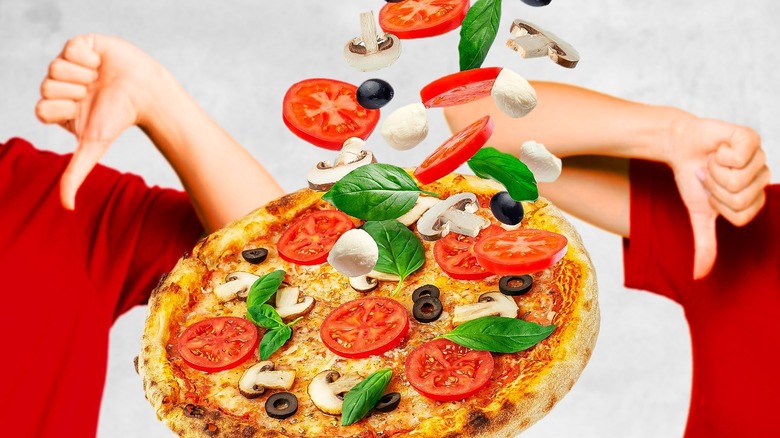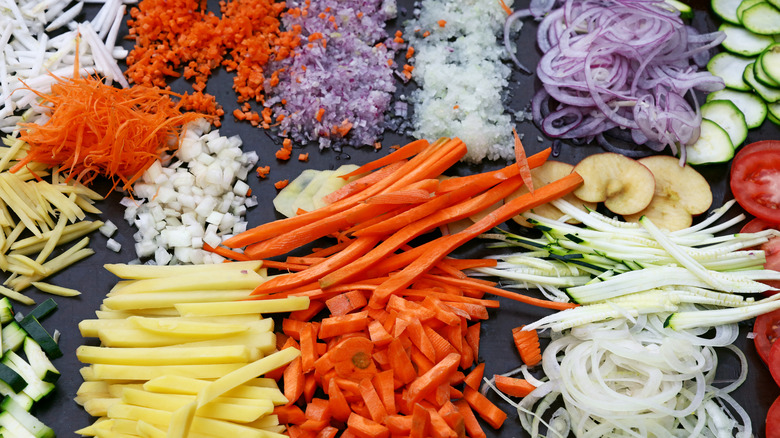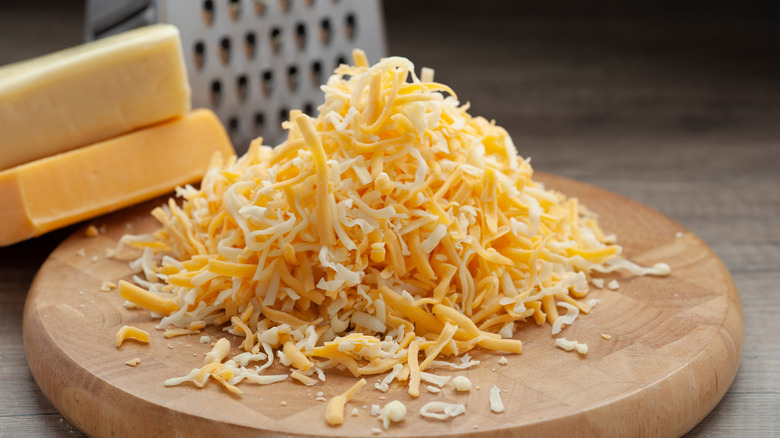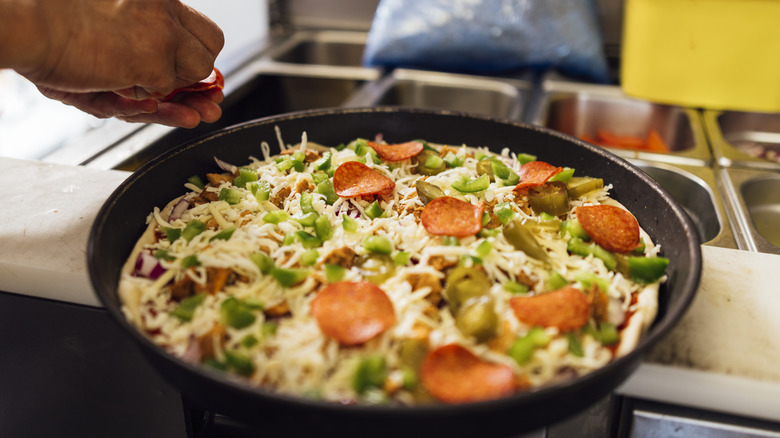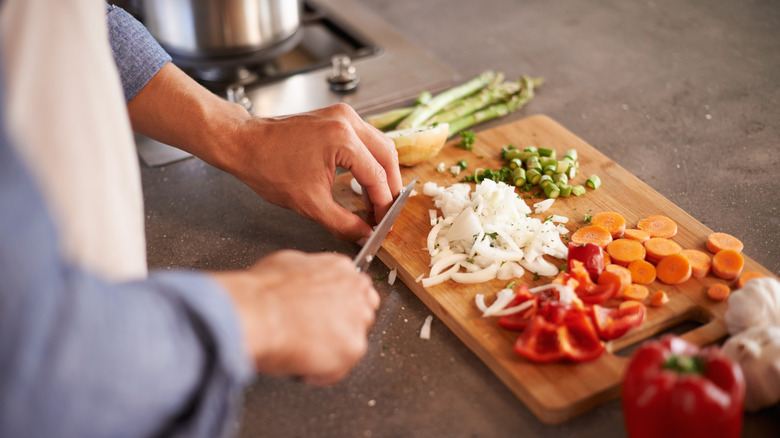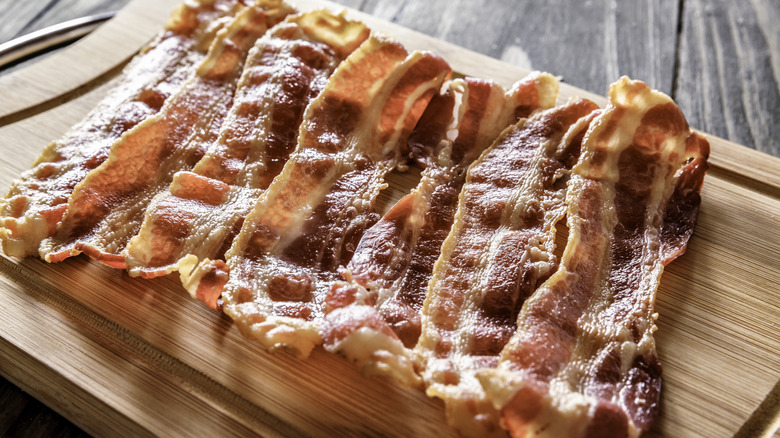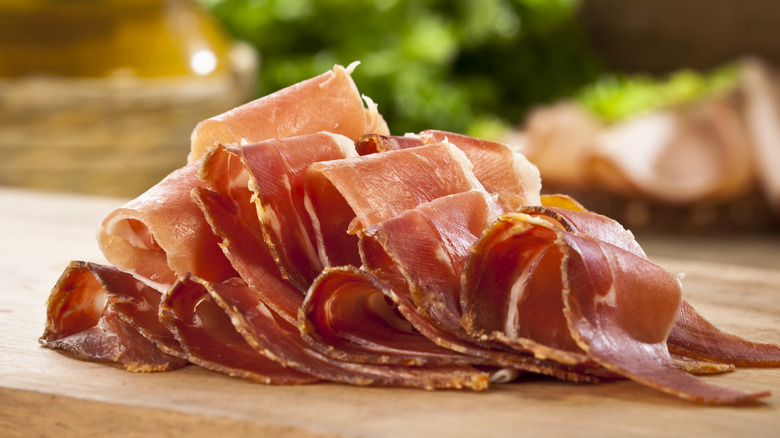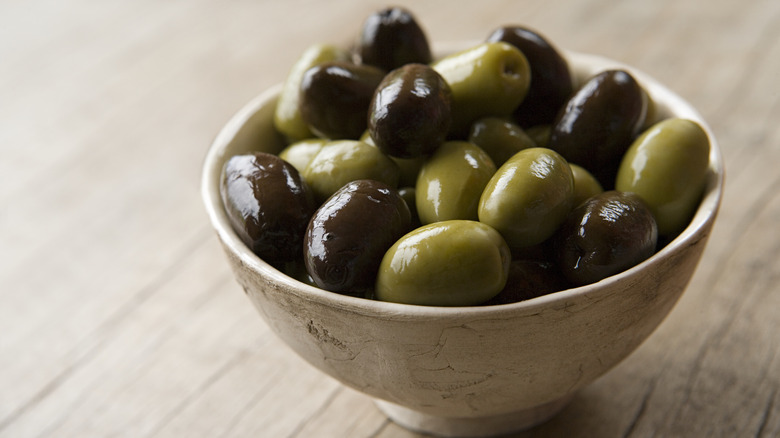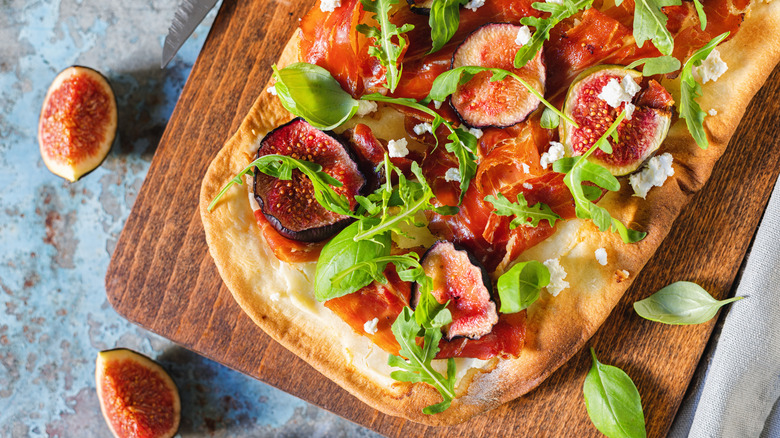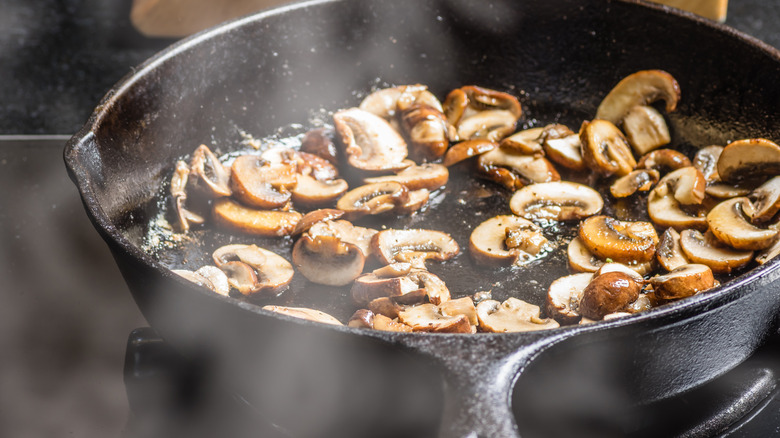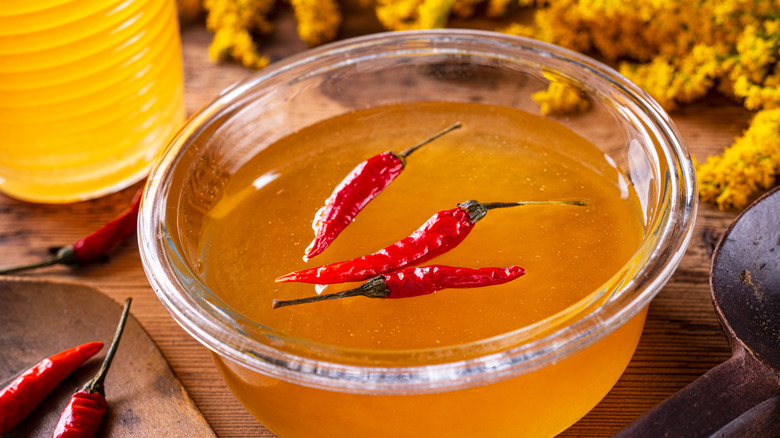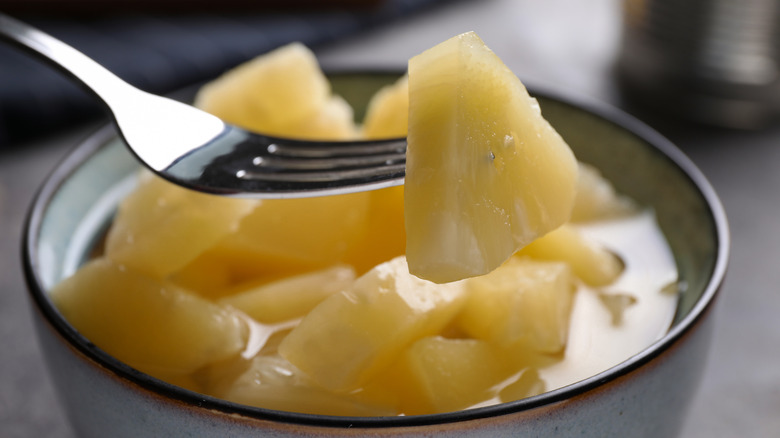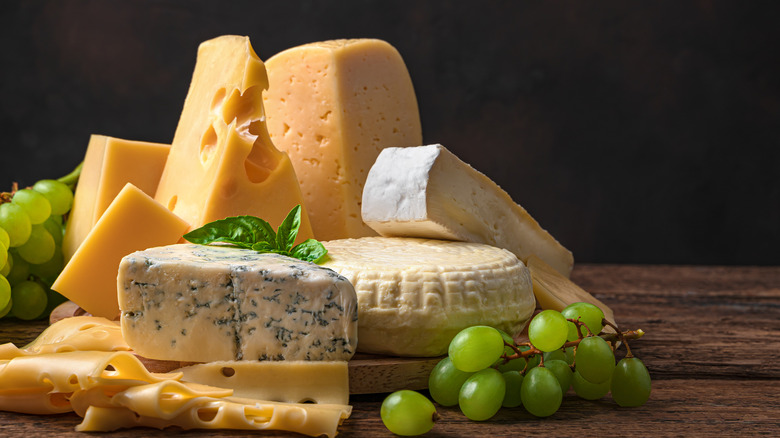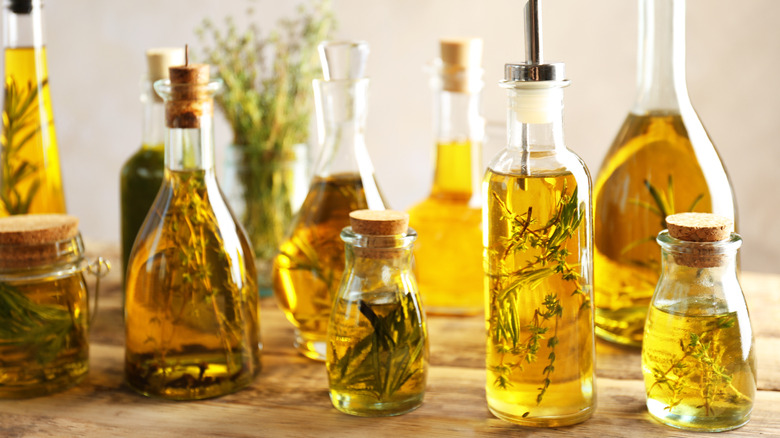14 Biggest Mistakes You're Making With Pizza Toppings
Pizza might very well be one of the best things to make at home. After all, you can customize each pie based on whatever your heart (and stomach) is craving, resulting in delicious slices that are hard to resist. It's also possible to tweak the pizza-making process based on your available time or skill level, whether you are making homemade pizza crust and sauce from scratch, or prefer to get the store-bought versions of each one. But as simple as making pizza can be, it's also important to be mindful of how you add the toppings, including the beloved cheese. Without the right approach, you might end up with a disappointing dish.
Admittedly, placing so much focus on the toppings may seem finicky, but they can truly make or break a pizza. Think about it: Different toppings cook at different rates, and sometimes different temperatures. This means you'll need to address each topping as an individual ingredient, rather than looking at the pizza as a whole. Plus, the way you add the toppings will determine the final structure, texture, and flavor of your pie. In other words, properly dressing a pizza takes practice, so it's essential to avoid the biggest mistakes people make when adding pizza toppings. By keeping an eye out for the following errors, you'll be well on your way to making the best homemade pizza ever.
Adding too many toppings
When making pizza at home, it can be tempting to pile on the toppings due to excitement (and hunger). However, more isn't always better, even on homemade pies. This mistake can weigh down the pizza crust and make it soggy, especially if you're using high-moisture vegetables like mushrooms or eggplant. Before you know it, the cheese and toppings will slide off as you eat, and you'll need a fork to tackle the messy situation.
Also, overloading the pizza with toppings can make it difficult to enjoy the individual flavors. This can detract from the other elements of the slice — i.e., the cheese, sauce, and crust — all of which are delicious in their own right and deserve a chance to shine.
To avoid this common pizza blunder, add only two or three toppings on thin crusts, and three to four toppings on thicker crusts. While you're at it, be mindful of the amount of toppings that you add on in total. As tempting it can be, you don't need to cover every inch of the pizza with toppings; you just need enough to taste each topping in every bite. As long as the toppings are evenly dispersed, you'll be good to go.
Overdoing the cheese
The cheese might be one of the best parts of a pizza (or any recipe, for that matter). But cheese, like the other toppings, should be added sparingly and mindfully to a pie. For starters, too much cheese can weigh down the pizza, causing each slice to fall apart when you pick it up. Cheese also naturally releases grease when cooked, so going overboard can result in an oily mess. This is even more likely if you use a high-fat cheese, such as cheddar or Brie.
Instead of dumping an entire package of cheese on a pizza and calling it a day, use just enough to cover the sauce. Again, focus on spreading the cheese evenly across the pie, which will ensure you get a generous amount of cheesy goodness in every bite. The cheese will spread as it melts in the oven, so there's no need to add a thick layer on your homemade pizza creation.
Loading the toppings randomly
It might not seem like a big deal, but when making pizza at home, you'll want to avoid adding toppings haphazardly. Remember, different toppings take different lengths of time to cook, and some will need more exposure to heat than others. If you add the toppings in a random order, you'll run the risk of undercooked or overcooked ingredients, resulting in a disappointing pie.
The key is to think about how long each individual topping needs to be cooked. Consider things like thickness, moisture, and whether or not the ingredient is still raw. In general, if you're using ingredients that burn easily, such as basil leaves, you'll want to add them under the cheese to prevent them from burning. After adding the cheese, you can then add cooked toppings (like pepperoni or cooked sausage), followed by raw ingredients (such as raw bell peppers). Since the top layer will be exposed to the most heat, adding the raw toppings here will ensure they're thoroughly cooked through.
Chopping raw ingredients into big pieces
In addition to the order and amount, it's worth considering the preparation of your toppings. Specifically, when chopping raw ingredients such as bell peppers, broccoli, and mushrooms, think about their size and how they'll be affected by cooking. If the pieces are too big, they won't heat all the way through, and you'll be left with a cooked pizza crust, perfectly melted cheese, and undercooked or unevenly cooked toppings. Plus, big pieces can weigh down the pie, especially if you're using a thinner crust.
With that in mind, always finely chop these raw ingredients so they'll cook evenly and properly on the pizza. Diced pieces are best, depending on the type of topping. It's also a good idea to cut them into equal-sized pieces, which will ensure they cook at the same rate. If you're concerned about any raw ingredients not being thoroughly cooked in the oven, you can always cook them separately on the stovetop and add them to the pizza once it's done baking.
Not pre-cooking raw meats
Is there anything more disappointing than preparing a tasty dinner, only to come down with food poisoning? Probably not. It's every home chef's worst nightmare, even more so when you're serving a crowd. So, if you decide to add meat (such as sausage or chicken) to your homemade pizza, don't make the mistake of not cooking the ingredients first. In addition to the pizza baking time, raw meats need more time to thoroughly cook — so if you add them to the pie while they're still raw, they'll be undercooked when the rest of the pizza is ready. This will pose a serious food safety issue, as eating undercooked meat increases the risk of foodborne illness.
The solution? Always cook raw meat before putting it on a pizza. Whether you cook it separately on the stovetop or in the oven, it doesn't matter; just be sure to cook meats first. While you're at it, use a food thermometer to check the internal temperature of the meat, which will indicate that it's been heated enough to kill sickness-causing germs. Ground meat and sausage should reach 160 degrees Fahrenheit, while poultry (including sausage and ground meat) should reach 165 degrees Fahrenheit.
Adding thinner meats before baking
Of course, you're not limited to sausage and ground meats for your homemade pizzas. Cured meats (such as smoked salmon and prosciutto) and cold cuts (such as sliced turkey and ham) also work well as pizza toppings. Not only are they delicious, but they'll offer a tasty contrasting texture to the crispy crust and melted cheese. However, unlike raw meats, cured meats and cold cuts don't need any cooking time, so it's best to avoid adding them to the pizza before baking. Otherwise, between the ready-to-eat nature of these meats and the thin nature of their slices, they'll quickly burn in the oven.
Instead, add thin-sliced meats after the pizza has been baked and just before serving. Alternatively, if you prefer your cured meats and cold cuts slightly warm, you can place them on the pizza a few minutes before it's ready. The trick here is to avoid exposing the thin meats to the entire pizza-baking time.
Either technique will maintain the texture, moisture, and, most importantly, the flavor of these meats. Just be sure to slice the meats into small pieces and evenly disperse them across the pizza so you can get just enough in every bite.
Topping with marinated ingredients too early
Marinated ingredients — such as pickled onions, canned artichokes, and olives — are so good on pizza. Their tangy acidic flavor add brightness to the pie, which is like a party for your taste buds. Plus, they offer a satisfying crunchy texture that will balance the rest of the pizza. But like thin-sliced meats, these marinated toppings shouldn't be added to the pizza before it's baked in the oven.
Since these ingredients are packaged in liquid, the heat of the oven will make them soft and mushy, potentially causing a soggy mess. They might also lose some of their tangy acidity during cooking.
To maintain their flavor and texture, marinated toppings should be added to the finished pizza — i.e., after it's been baked. Additionally, don't forget to drain them well to avoid adding extra moisture to your pizza. You could also pat marinated toppings dry with a paper towel or clean fabric towel before adding them.
Adding fresh greens too soon
When it comes to pizza toppings, you can't go wrong with fresh greens like arugula, spring greens, and microgreens. They're perfect for adding a pop of color, earthy flavor, and contrasting texture. It also doesn't hurt that they're packed with essential nutrients like vitamin C and iron.
However, fresh greens shouldn't be added before the pizza is baked, as they'll lose their flavor and texture when exposed to high heat. The same goes when adding fresh herbs to your pizza, such as basil or parsley. So, to enjoy the best of what fresh greens have to offer, add them to the pizza after baking.
But what if you actually prefer these ingredients cooked? (Hey, to each their own.) In that case, make sure to add them under the cheese to ensure they don't burn and shrivel up. Remember, the top of the pizza will be exposed to the most heat, so reserve this layer for raw ingredients that need more cooking time.
Adding watery ingredients without pre-cooking
Almost every vegetable has a place on homemade pizza. But for high-moisture vegetables like eggplant, tomatoes, and mushrooms, placing them directly on an unbaked pizza while they're still raw is a huge mistake. That's because these items will release moisture in the oven, ultimately becoming mushy and creating a sad and soggy pie.
Fortunately, pre-cooking vegetables won't take long, and it's totally worth the extra effort. Simply roast or sauté the vegetables until they're partially cooked, then add them to the pizza as usual. Another option is to cook them thoroughly and put them on the finished pizza when it comes out of the oven. For toppings like eggplant slices, you can even salt them first to draw out excess moisture. To do this, sprinkle the eggplant slices with a bit of salt, let them sit for a few minutes, then press them between paper towels or clean cloth towels to squeeze out the extra water.
Avoiding sweet ingredients
If you're overlooking sweet ingredients when making pizza, you're missing out. The addition of a sweet topping can transform your pie into a medley of mouthwatering flavors. What's more, the sweetness will balance the salty, savory, and fatty notes of your pizza, resulting in a well-rounded pie.
But don't worry — you're not limited to pineapple, a popular sweet pizza topping that might also be the most polarizing. Fruits like pears, figs, blackberries, peaches, and strawberries also work well on pizza, particularly with gourmet cheeses and non-tomato-based sauces. Better yet, you can grill or bake fruit slices before adding them, which will help remove excess moisture and coax out their natural sweetness.
Now, you're not limited to fruits when it comes to sweet ingredients to add on homemade pizza; maple syrup, hot honey, and candied nuts (like pecans or walnuts) are unique and tasty options. Unlike fruits, these should be added to the pizza after it's baked to avoid sticky condiments and burnt nuts, respectively.
Not draining canned or cooked ingredients
Canned vegetables and fruits are the unsung heroes of the homemade pizza world. For starters, they're shelf-stable, making it easy to stock your pantry with an array of pizza toppings. Canned produce also makes it possible to enjoy certain ingredients even when they're not in peak season (think peaches during the winter months.) The only catch? If you were to add these toppings straight from the can, your pie will become a gross and soggy mess.
Before using canned vegetables or fruits, take a moment to drain them using a mesh strainer. This is especially important when draining fruits in heavy syrup, as you probably don't want a sugary liquid on your pizza. You can also pat the ingredients dry with a paper towel and briefly pre-cook them, which will help reduce any lingering excess moisture.
Also, after pre-cooking high-moisture vegetables like mushrooms, draining and patting dry is key. These ingredients can release a lot of moisture during the pre-cook stage, so getting rid of extra water will protect your precious pie.
Using just one type of cheese
Whether you love classic mozzarella or sharp cheddar cheese, limiting yourself to one type of cheese is a pizza mistake you don't want to make. After all, adding just one other type of cheese is not only easy to do, but it will completely elevate the flavor of your pie. And depending on the varieties you use, the cheeses can offer contrasting textures, further adding to the deliciousness.
Luckily, there are plenty of ways to combine different types of cheese when making pizza. One option is to mix two (or three) types of shredded cheese to make your own custom blend. Alternatively, you can use traditional mozzarella, then add cheese with a completely different texture.
For example, hard cheeses like shredded Parmesan won't melt as much when baked, but they'll offer a deliciously sharp flavor to the dish. Or if you prefer something richer, add slices of Brie or dollops of a creamier cheese, like ricotta.
Drizzling condiments before baking
The tomato sauce might be the star of the show, but sometimes you just need a little extra something on your pie. Enter condiments, oils, and non-tomato-based sauces, which can be drizzled onto your pizza for extra flavor. However, it's not always a good idea to do this before the pizza is baked, as not all options hold up well in the oven. The extra moisture might also negatively affect the other toppings, as well as the integrity of your crust.
For example, if you love extra-virgin olive oil or flavor-infused oils on pizza, wait until after the pizza is done baking to add the oil. This will preserve its flavor and ensure that any oils with lower smoke points don't burn in the oven. Likewise, if you want a punch of flavor from hot honey or balsamic glaze, add it to the pie after baking. The reason? Both options are high in sugar, so they'll become too sticky when heated.
Not preparing your toppings in advance
If there's only one pizza topping mistake to avoid, it's this one: neglecting to prepare the toppings in advance. In other words, once you've stretched the pizza dough and topped it with sauce, do your best to add the prepared toppings immediately. Otherwise, if you still need to cut and pre-cook the toppings, the dough and sauce will sit too long at room temperature, increasing the risk of the dough sticking to the work surface. In addition, wasted cooking time means you'll have to wait even longer to eat your homemade pizza.
The fix for this mistake is easy: Prepare your toppings in advance, whether that involves chopping, draining, or pre-cooking. This is particularly helpful if you're hosting a pizza-making party, as it will limit the chaos of people cutting or cooking toppings in the kitchen. Just avoid keeping anything out for too long for the sake of food safety; produce and cooked foods, including meat, should not sit at room temperature for more than two hours.
